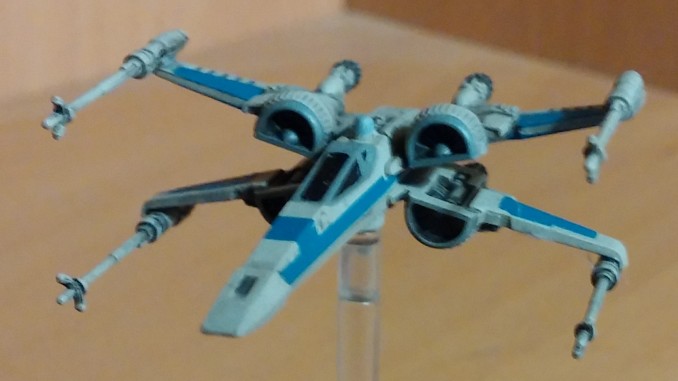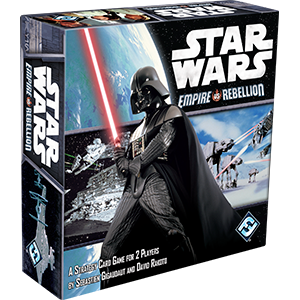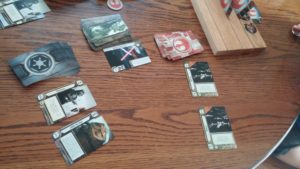

After a recent X-wing tournament I came away with a little bit of store credit. Having no X-wing models I had a need of I took a stroll through their well stocked game section. I’m always on the look out for good two player games I can play with my wife. And lo and behold, what should I discover on the shelves but the Star Wars: Empire vs Rebellion card game.
I had heard briefly about this game awhile ago and since its price of $12.95 was fully covered by my store credit winnings I picked it up without a second thought. Compared to many games costing $30 to $70 this was a steal.
For your small investment you get two decks of cards all with movie still art and a set of card board tokens. The game play is pretty simple to pick up. You and your opponent take on the roles of the Empire or the Rebellion and are competing to complete Events and be the first to acquire seven victory points.
Each round consists of three phases: Planning, Struggle and Dominance. During the Planning phase an Event card is revealed. You will be competing to win this Event as it is the source of victory points. Each card allows you to play a different number of cards (Capacity) and an Objective Value. The Objective Value is the number you’re trying to reach, without going over, with your Resource Cards (the cards you play during the round).
After the Event Card is revealed each player secretly picks a Strategy card. There are five of them that you can choose from that will have an effect at the end of the round. Some give you some benefit even if you lose the round. Some help make it easier to win the round, such as one making it so the person who would have lost ends up winning. You can only use each card once, until you’ve exhausted all five.
 Once the Strategy card is picked you move on to the Struggle phase. This is the phase where you actually play the game. Each player takes a turn where they have four choices of actions. They can draw and play a card. (You don’t have a hand, you just draw off the deck and put the card into play). You can use the power on a card that is in play which causes it to become exhausted. You can spend an Influence token to unexhaust a card in play. Or you can pass.
Once the Strategy card is picked you move on to the Struggle phase. This is the phase where you actually play the game. Each player takes a turn where they have four choices of actions. They can draw and play a card. (You don’t have a hand, you just draw off the deck and put the card into play). You can use the power on a card that is in play which causes it to become exhausted. You can spend an Influence token to unexhaust a card in play. Or you can pass.
Because each Event allows for a different number of cards to be in play and for a different Objective your goals vary each time. The value of each Resource card ranges from 1 to 6 and the Objective value on the Events range from 5 to 21. This can lead to playing two cards and overshooting your goal by a lot which can make for some quick rounds. Or you can be dancing around your target number as you and your opponent keep removing cards from play.
There are four basic card types and then a separate pool of character cards. The basic cards are Recon, Diplomacy, Military and the Force. Recon allow you to look at the top two cards in one of the decks and decide which card will be on top, discarding the other. This is really useful when drawing one more card might put your over your Objective value. Diplomacy cards allow you to discard one of your cards in play. This is great when you draw two five point cards in a row and your target is a low number.
Military cards (appropriately pictured with Star Destroyers or X-wings) allow you discard one of your opponent’s cards. And finally Force cards allow you to exhaust one of your opponent’s cards. These are really useful when your opponent has a Military card sitting ready to remove one of your cards.
Finally, character cards have a whole range of powers. This can be anything from changing your or your opponent’s Strategy card to discarding cards to searching your deck for specific cards. Each character is one of our heroes or villains from the original three movies. The Empire naturally has to scrape for less major characters (IG-88, General Veers for example) while the Rebels are all major players.
You start with four of the eight characters in your deck and certain Events, Strategies and powers allow you to add more to your deck. The main unique feature of the characters is that they have a variable Resource value. They each are worth six points when they are first played but if you exhaust them to use their power they become worth only one point. This can put you in a position where using their powers means you go from winning to losing. But it can also be useful for those lower score Events when shedding five points gets you back under the target number.
Overall, it’s a pretty easy game to get into and plays fairly quickly. It can start to drag on a bit when you and your opponent are constantly fighting over Events that are each worth only one Victory point. When you’re going back and forth trying to get to seven it can take awhile.
But the main thing that surprised me about this game is that my four year old managed to play and loves it. I mean really loves it. We’ve played twice a day for a week now. I got it with the intention of playing with my wife but haven’t yet because I’m burned out playing with him.
For the most part, it’s simple enough for a kid to figure out. I had to explain what all the cards do to him, and remind him occasionally, but once he picked it up he didn’t need to actually read any of the text. The biggest challenge for a kid playing is you need to be able to do addition of multiple numbers beyond twenty.
And this, frankly, surprised me about him. He’s always been quick with numbers, being able to count very early, being able to read and count in the hundreds and adding already. But this game has propelled him to a whole new level.
He loves the game so much he’s pushing past the challenge of adding five different numbers together. This has turned the game into an excellent teaching tool, so despite my burn out from a week of playing, I’m happy to keep doing it
So overall, this game gets a seal of approval. It’s a great value for its price. Adults might tire of it after a few plays but you don’t need to play it more than a few times to get your money’s worth. It’s small, so therefore easy to transport and doesn’t require much play space. This makes it a perfect game to pull out when you need to kill a little bit of time.
And if you have kids that love Star Wars and could use some practice with basic addition and subtraction, it’s a great teaching tool.
